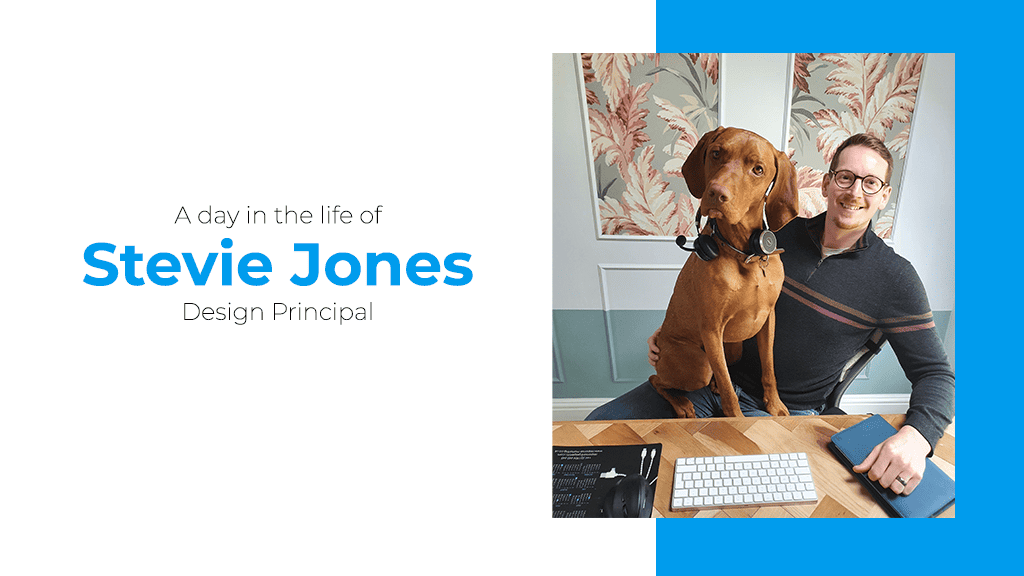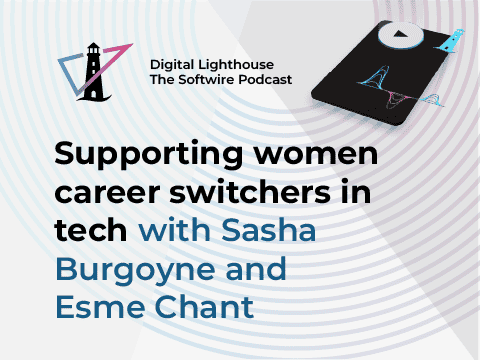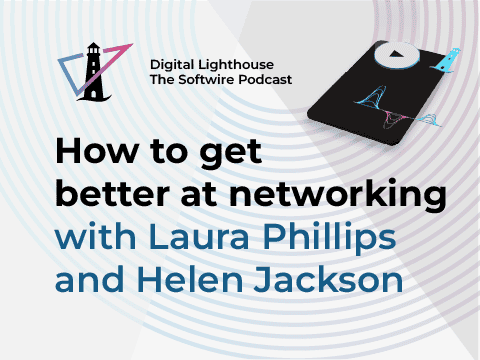
Hey, I’m Stevie Jones. My job is Design Principal, which means I’m responsible for delivering design work and projects, owning all aspects of the delivery: design vision, design delivery, and team and client management.
I’m part of and I report to (and work closely with) the Design Director, who heads up my team, and the Client Directors, who are responsible for portfolio performance and account management of the clients.
What does a Design Principal do?
My role is split into three areas:
- Defining the best outcome for the client: My role is to understand the customers’ strategic needs and create a design strategy to meet them, which incorporates the user needs. I define where it’s useful to invest time in projects for the most amount of value, arranging the plans and monitoring the progress. Ultimately, I try to ensure success for the customer by proposing the best direction to take to achieve the client and user goals. When the direction of the work has been arranged, I am the point of contact for stakeholders and manage their expectations. I’ll proactively identify and address risks throughout and I act as the ultimate escalation point for design-related issues.
- Supporting Softwire to its commercial aims: This line of work includes estimating scope, monitoring project budgets and ensuring quality assurance of our deliverables. I also work closely with the client directors, to understand what opportunities exist within the portfolio of clients and help to shape those opportunities early on through sales bids and pre-sales conversations.
- Accelerating the careers of junior designers: I have line management responsibilities to junior members, who I want to keep happy and professionally fulfilled. At the same time, I want to make sure the right people are on the right teams, so that everyone gets opportunities to progress their careers in the ways they want.
Real-life examples of my daily work at Softwire
Planning the right team for the customer’s requirements
For one large public sector client, we were asked to deliver a new app that had a strong design-first focus. My team led on the project, and I helped the client think about how we can evolve the plans into something that could be designed, validated and launched successfully across both Android and iOS.
In this case, it was my job to explore the opportunity space, what design processes and methodologies we should be use, and whether there would be additional support needed (like coding and technical services). From this, I could plan the strategy with the project governance team for what was required, when and by who – designers, developers, and other specialists – and then collaborate with the internal resources to make it happen.
Helping on pre-sales bids to secure new business
I’m now more involved in pre-sales meetings with new clients to try to unlock opportunities for new design business. At these meetings, I’m introduced into a new project that senior management want me to run, or I start from scratch and discuss the client’s end goals and vision. Sometimes, there will be a clear set of requirements, but where there is no clarity, I’ll act as a consultant and work with stakeholders to define the project parameters.
One way to do this is to facilitate a workshop over two hours, which brings together the client with the product owner, delivery lead and internal team members. I use this time to outline the goals, the user needs and run through ideas, getting everyone’s views and opinions. By working through the problems, and prioritizing and focusing on solutions, I can help identify the opportunity space and how to achieve it in manageable chunks.
Supporting junior colleagues with their careers
I have regular one-to-one meetings with junior colleagues in my team, as part of my role is to support and encourage their development. There are discussions about working towards their career goals, reviewing their work progress over the last few weeks, and ensuring the work they’re doing is the right work for their career development goals.
Along with these meetings, I have a Monday-morning design and research team stand-up meeting with the whole team. This helps us all to share the direction of our work for that week and is a great opportunity for junior colleagues to raise blockers and practice their skills such as showcasing their latest work. I discuss and trouble-shoot any challenges in front of the whole team so that everyone benefits and learns.
Acting as design lead for internal staff and clients
I’m very experienced with different kinds of digital disciplines. I started work as a front-end developer, moving into visual design and then UX design as my career progressed. This background helps me empathize with the different roles within my project teams, understanding their processes and methods. It helps me communicate well with my peers about upcoming tasks, tackling delays head-on to ensure that work is completed in a timely manner.
This wider awareness of how tasks and people pragmatically come together means I can be useful to the client, providing a clear overview of how the project work is progressing. I’m regularly in client meetings to feed into the discussions, elevate any points that have been raised by my team, catch up on things that need to be addressed and explain the value of taking the actions we recommend.
Supporting teams with their day-to-day work
Each week, my list of tasks changes according to the work that is scheduled and the opportunities that come up. Because of this, there is a lot of variety to each day and that makes my job interesting. I could be:
- Acting as the internal quality control reviewer for internal team members, to make sure the work meets the project goals and ensure our rationale/storytelling is on point ready for the client to review at each stage
- Leading or supporting a design demonstration and client presentation
- Resolving any escalated design issues that need more experience or investigation
- Talking to other teams about integration, testing, and delivery
- Supporting Scope Of Work (SOW) creation so that I can direct task work to begin
- Providing tailored feedback from my meetings with client directors or the design director
Work-Life balance at Softwire
I work from 9am to 5.30pm, with plenty of coffee breaks and I take at least a half-hour lunch break to have a good period of time away from my desk.
I’m based in Staffordshire and associated with the Manchester office, but have great connections with the London office too where most of the design team are (although we’re looking to hire up north too!). I really like the large whole-company events, like the Softwire music festival and our annual company holiday, that bring all offices together to have fun.
I plan to bring my dog Vinnie Jones in to meet everyone sometime soon, he’s been a common feature on our design team meetings over the pandemic and gave us a good few laughs.
Generally, the biggest feel-good draw for me is Softwire’s emphasis on charity-giving. I like to take part in charity matching and there are always events and fundraisers to help make a difference to local and national charities. A close second, is being able to buy/sell holiday which gives some extra freedom when needed, such as when I took on a big renovation project and got married in the same year!
How to become a Design Principal at Softwire
I’m quite pragmatic person and enjoy guiding work in the right direction towards meeting a certain objective or goal.
I’m in the heart of the design work happening at Softwire, so I get to make real impact to the clients I work with and collaborate with talented colleagues, whilst evolving our design offering and ways of working to enable us to grow.
I love it when I can use my knowledge and experience to evolve an idea into a final product that the client and customers really loves.
Want to become a Design Principal too? Find out more about the salary, benefits package and apply to join by visiting our Careers site.


